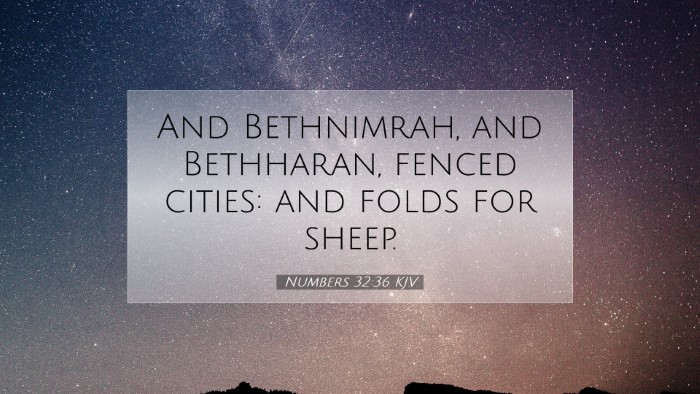Commentary on Numbers 32:36
Numbers 32:36 states:
"And Beth-nimrah, and Beth-haran; fenced cities: and sheep coats." (KJV)
Context and Background
This verse falls within the larger narrative of the Israelites' journey to the Promised Land, focusing particularly on the request made by the tribes of Reuben and Gad to settle on the eastern side of the Jordan River. Their request indicates a significant moment in the history of Israel as they grappled with their identity as a nation in the midst of war and striving toward fulfillment of God’s promise.
Geographical Significance
Beth-nimrah and Beth-haran are landmarks that deserve attention from both a geographical and theological perspective. These cities were fortified, indicating the need for protection from potential threats and symbolizing the precarious position of the Israelite tribes during this transitional period.
Historical Context
- Location: Both cities are thought to be located in the northern area of Gilead, close to the Jordan River. Their geographical positioning is key, as it illustrates the isolation imbued within the eastern tribes, separate from the primary Israelite communities settling in Canaan.
- Strategic Defense: The construction of fortified cities like Beth-nimrah and Beth-haran reflects an understanding of the constant threat of neighboring nations and the need for security in a tumultuous time.
Theological Implications
This brief verse encapsulates numerous theological themes vital for understanding God's plan and His people's behavior.
- Divine Promises: The building of cities signifies God's faithfulness in providing a land for His people. Additionally, it reflects the tribes' responsibility in fulfilling their commitment to the land as part of the covenant relationship with God.
- Responsibility of Leadership: The request of Reuben and Gad highlights the need for effective leadership. Moses had to navigate between the desires of individual tribes and the overarching goals for Israel as a nation.
- Faith and Obedience: The actions of the Reubenites and Gadites prompted discussions about faithfulness and obedience. Their choice to remain on the eastern side of the Jordan stands as a poignant moment that provokes deeper inquiry into the cost of spiritual vocation.
Commentary Insights
Matthew Henry's Commentary
Matthew Henry emphasizes the importance of stable dwelling places and the role these cities play in providing refuge. He remarks on the desire for security and how this human instinct must be balanced with spiritual commitments.
Albert Barnes' Commentary
Albert Barnes highlights that the naming and fortification of these cities serve as a reminder of God’s provision. He elucidates that the presence of sheep coasts indicates both agrarian lifestyle and reliance on divine providence.
Adam Clarke's Commentary
Adam Clarke elaborates on the military implications of this verse, stressing the importance of preparation. He asserts that the choice of these cities reflects a proactive approach toward defense and living according to the needs of the community.
Lessons for Today
This examination of Numbers 32:36 can provide contemporary readers with pivotal lessons:
- The Importance of Strong Foundations: Just as the Israelites built fortified cities, modern believers must lay strong spiritual foundations for their lives and communities.
- Understanding Our Generational Responsibility: Each generation must grapple with the decisions of their predecessors. The geographical choices made by the tribes of Reuben and Gad remind us of the implications of our choices for future generations.
- Faith in Action: The balance of faith and practical action is crucial in fulfilling God’s will. The commitment of the tribes serves as a model for integrating belief with practice.
Conclusion
In summary, Numbers 32:36 encompasses a wealth of insights and contextual significance that enrich our understanding of Israel's journey and their relationship with God. The interplay of geography, leadership, faith, and obedience is a rich tapestry that speaks to both the historical and contemporary reader alike. Pastors, theologians, and students of the scripture can glean from this passage practical, doctrinal, and moral lessons that are tightly woven into the fabric of biblical history.


